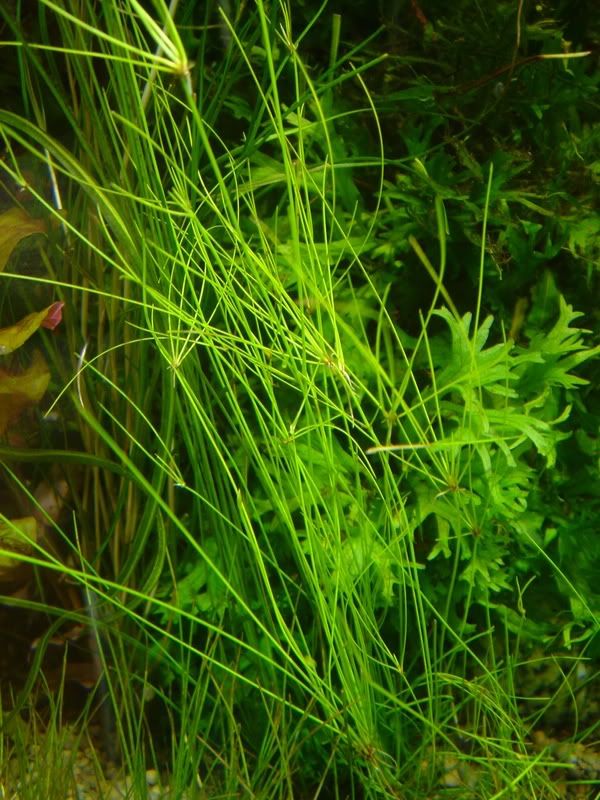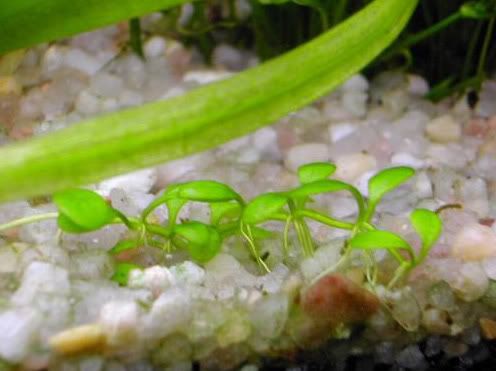Flora #38: Glossostigma elatinoides
Common Name: Glossostigma elatinoides, glosso
Scientific Name: Glossostigma elatinoides
Local Name: Glossostigma elatinoides, glosso
Origin: New Zealand
Native to Philippines (Y/N): N
Light Level: High to Very High
CO2 Requirement (Y/N): Y
Fertilizer Requirement (Y/N): Y
Life Span:
Freshwater/Brackish/Marine: Freshwater
Water pH: 5 - 7.5
Water Hardness:
Common Illness/Problems:
Growth: Medium to Fast
Length/Size: 2 - 3 + cm
Difficulty: Medium to Very Difficult
Tank Position: Foreground
Water Current/Movement Issues:
General Description:
Glossostigma elatinoides is much in demand in Japanese-inspired aquariums. It is one of the smallest
aquarium plants, and thus a good foreground plant. A difficult plant demanding a lot of light. Grows upwards if light is poor. Make sure larger plants do not overshadow it. When planting in the aquarium small clumps (approx. 1/8 pot) should be placed at intervals of a few centimetres to help the plants grow together more quickly. CO2 addition and soft water promote growth significantly. Avoid placing in shaded or covered area.
Other Important Information:
Flora #39: Marsilea hirsuta
Common Name: Marsilea hirsuta
Scientific Name: Marsilea hirsuta
Local Name: Marsilea hirsuta
Origin: Australia
Native to Philippines (Y/N): N
Light Level: Low to High
CO2 Requirement (Y/N): Y
Fertilizer Requirement (Y/N): Y
Life Span:
Freshwater/Brackish/Marine: Freshwater
Water pH: 5 - 7.5
Water Hardness:
Common Illness/Problems:
Growth: Medium
Length/Size: 2 - 5 + cm
Difficulty: Medium to Difficult
Tank Position: Foreground
Water Current/Movement Issues:
General Description:
Marsilea hirsuta is a fascinating plant, usually delivered with leaves like a four-leaf clover. After a transitional period it develops different types of leaves, possibly a low form with single leaves like a large Glossostigma, or alternatively develop two, three or four-lobed leaves varying in height, depending on the growth conditions. Whichever form the plant adopts, it forms runners and spreads rapidly round the aquarium. The scientific name for this unusual aquatic fern has not yet been finally settled. It will spread via runners and shoots. Two similar varieties, Marsilea drummondi and Marsilea crenata are occasionally available.
Other Important Information:
Flora #40: Ludwigia arcuata
Common Name: Ludwigia arcuata
Scientific Name: Ludwigia arcuata
Local Name: Ludwigia arcuata
Origin: North America
Native to Philippines (Y/N): N
Light Level: High to Very High
CO2 Requirement (Y/N): Y
Fertilizer Requirement (Y/N): Y
Life Span:
Freshwater/Brackish/Marine: Freshwater
Water pH: 5.5 - 8
Water Hardness:
Common Illness/Problems:
Growth: Medium
Length/Size: 2 - 5 + cm
Difficulty: Easy to Medium
Tank Position: Midground to Background
Water Current/Movement Issues:
General Description:
This is a narrow-leafed Ludwigia-species, so it is often mistaken for Didiplis diandra. It requires a relatively large amount of light before forming a red stem and red leaves, and thrives best in slightly acidic, soft/ medium hard water. The most decorative effect can be achieved by planting it in groups. It is suitable for small aquariums, and can also be used as a terrarium plant.
Other Important Information:
Results 21 to 30 of 193
-
11-30-2009, 08:37 PM #21
Last edited by gaevwa; 11-30-2009 at 08:43 PM.
-
11-30-2009, 09:04 PM #22
Flora #41: Ludwigia glandulosa

Common Name: Ludwigia glandulosa, Ludwigia perennis
Scientific Name: Ludwigia glandulosa
Local Name: Ludwigia glandulosa, Ludwigia perennis
Origin: North America
Native to Philippines (Y/N): N
Light Level: Medium to Very High
CO2 Requirement (Y/N): Y
Fertilizer Requirement (Y/N): Y
Life Span:
Freshwater/Brackish/Marine: Freshwater
Water pH: 5.5 - 8
Water Hardness:
Common Illness/Problems:
Growth: Medium
Length/Size: 15 - 40 cm
Difficulty: Difficult
Tank Position: Midground
Water Current/Movement Issues:
General Description:
Ludwigia glandulosa is a very beautiful water plant. It is slowgrowing and requires CO2 addition to grow well. The leaves turn greener if sufficient light is provided. Used to be sold as Ludwigia perennis. Unlike other Ludwigias, L. glandulosa does not like to branch. Even when this plant grows right up to the water line, it tends not to branch, but rather grows out of the water. To force side shoot growth, one usually has to snip the tip of the stem. Because of the intense coloration of this plant, L. glandulosa is ideal as a focal point plant. Its intense red/purple leaves will easily attract the eye. Because this plant is not extremely fast-growing and does not often branch, one can easily use this plant in the Dutch-style plant streets.
Other Important Information:
Flora #42: Eleocharis vivipara

Common Name: Eleocharis vivipara, Umbrella grass
Scientific Name: Eleocharis vivipara
Local Name: Eleocharis vivipara, Umbrella grass
Origin: North America
Native to Philippines (Y/N): N
Light Level: High to Very High
CO2 Requirement (Y/N): Y
Fertilizer Requirement (Y/N): Y
Life Span:
Freshwater/Brackish/Marine: Freshwater
Water pH: 5.5 - 8
Water Hardness:
Common Illness/Problems:
Growth: Fast
Length/Size: 50 + cm
Difficulty: Easy to Medium
Tank Position: Midground to Background
Water Current/Movement Issues:
General Description:
This grasslike plant can be used as specimen or midground plant and may reachup to 50cm in length. New plantlets are created at the top of the leaf, giving the plant its "umbrella" appearance. Good lighting and soft water will both prove beneficial. Allow space for growth in the tank. This can be grown emersed.
Other Important Information:
Flora #43: Eleocharis aciculares

Common Name: Eleocharis aciculares, Hairgrass
Scientific Name: Eleocharis aciculares
Local Name: Eleocharis aciculares, Hairgrass
Origin: Worldwide
Native to Philippines (Y/N):
Light Level: High to Very High
CO2 Requirement (Y/N): Y
Fertilizer Requirement (Y/N): Y
Life Span:
Freshwater/Brackish/Marine: Freshwater
Water pH: 5.5 - 8
Water Hardness:
Common Illness/Problems:
Growth: Fast
Length/Size: 15 - 20 + cm
Difficulty: Easy to Medium
Tank Position: Midground to Background
Water Current/Movement Issues:
General Description:
This commonly available grasslike plant will vary in height depending on light conditions; brighter light will produce shorter plant. Good fertilization and debris-free environment will prevent the plant from dying back. Scavenging fish can disturb the plant leaves and remove the debris. Dense plants can be separated and replanted, which will encourage new growth.
Other Important Information:Last edited by gaevwa; 11-30-2009 at 09:16 PM.
-
11-30-2009, 10:00 PM #23
Fauna# 5: Ninja Shrimp

Common Name: Ninja Shrimp
Scientific Name: Caridinia serratirostris
Local Name: blue shrimp (due to morph),black shrimp (due to morph), ninja shrimp,chameleon shrimp (pet shops)
Origin: Japan
Life Span:
Temperament: docile, timid
Tank Compatibility Issue (for both Flora and Fauna): compatible w/ any plants, preferably large leaves or miniscule leaves (large for hiding, mini for grazing algae). Compatible w/ small fishes like danios and tetras.
Freshwater/Brackish/Marine: Freshwater (when adult), Brackishwater (when juvenile), Saltwater (living as plankton)
Water pH: difficult to attain
Water Hardness: difficult to attain
Schooling/Non-schooling: Non-schooling
Common Illness/Problems: heavy metal contamination, salinity, predation and bullying, shipment stress, and environmental stress
Growth: slow
Length/Size: 2.5 to 3.5 cm
Difficulty: Difficult
Water Current/Movement Issues:
General Description:
The Ninja Shrimp gets its name from its ability to change its colors completely "on the fly", so the "original shrimp" disappears like a ninja. This Shrimp is particularly popular in Japan, but has not found wide distribution elsewhere. At this point I do not know of any shrimp keepers or breeders in North America or Europe who even have this shrimp. To my knowledge C. serratirostris has never been imported to the US and Europe. This shrimp has an incredible array of color varieties, that not only depend on its mood but seem to be distinct geographic variations. There are black and white shrimp, red and white shrimp, all red shrimp with a white, vertical line on their backs and brownish speckled shrimp.
Other Important Information:
As stated above, the Ninja Shrimp requires saltwater in order to breed. Breeding species which require saltwater, like the Amano Shrimp, is very difficult. Salinity levels are very important during certain larval stages as well as feeding the larvae. Larvae must adjust slowly to pure freshwater over a period of time and their feeding must be closely monitored. The Ninja Shrimp can be bred in captivity but it may be a very difficult task to complete. Feeding the Ninja Shrimp is very easy as long as they are happy and healthy. Only feed an amount of food that the shrimp can finish within 2-3 hours maximum. It is not good to feed in excess and have food sitting for too long. Overfeeding is a known cause of death and can also cause water quality issues. Remember that shrimp are scavengers in the wild. They will eat whatever they find and are not used to a constant food source 24/7. Not feeding for one or two days is fine and will not harm this species at all. Sometimes I will not feed for a couple of days in order to let the shrimp cleanse their systems and keep the water clean at the same time. The Ninja Shrimp has earned its name from its ability to rapidly change colors and vanish, like a Ninja. There are many different names for this same species including Christmas Shrimp, Honey Shrimp and more. The only downside to this species is that it requires saltwater to reproduce.
References:
Ninja Shrimp .:. Caridina serratirostris .:. Freshwater Aquarium Shrimp Species Information Page
Petshrimp.com -- All about shrimp
Caridina serratirostris - Wikipedia, the free encyclopedia
Ninja Shrimps - Hanapin sa Google
-
11-30-2009, 10:03 PM #24
-
12-01-2009, 04:42 AM #25
@GAevwa - thank you for featuring Flora 27 up to Flora 37 which are the plants inside my nano tank. Could you add also my newly arrived plants from Manila (Thanks to Allister)?
1. Nomophila pusillus
2. Hygrophila balsamica
3. Cryptocoryne balansae
4. Barclaya longifolia
-
12-01-2009, 04:43 AM #26C.I.A.

- Join Date
- Mar 2007
- Gender

- Posts
- 3,081
-
12-01-2009, 09:48 PM #27
-
12-01-2009, 09:52 PM #28
gamay nang anubias barteri or ang minima mui gamai?
-
12-01-2009, 09:54 PM #29
-
12-01-2009, 09:57 PM #30
Advertisement
Similar Threads |
|







 Reply With Quote
Reply With Quote



